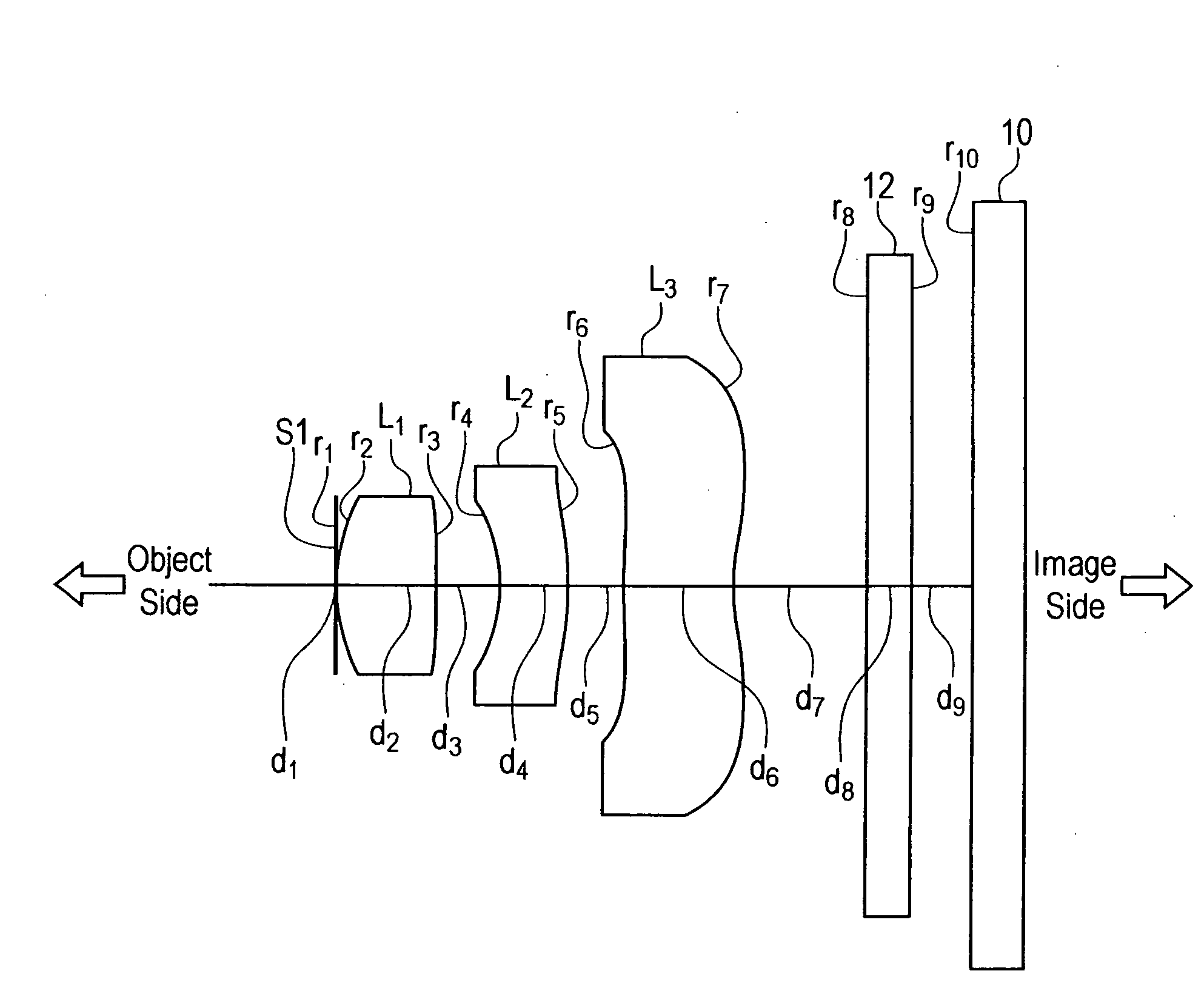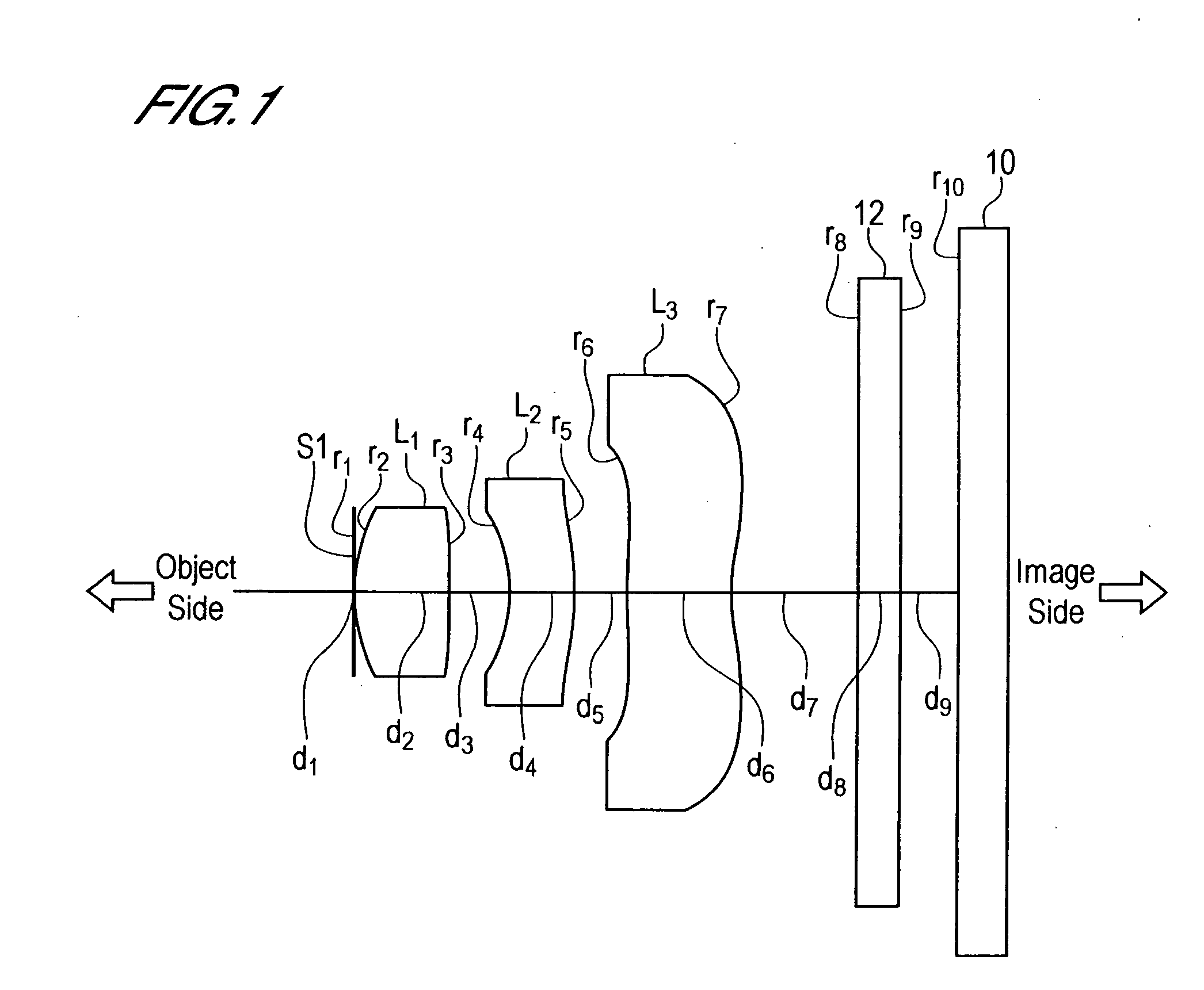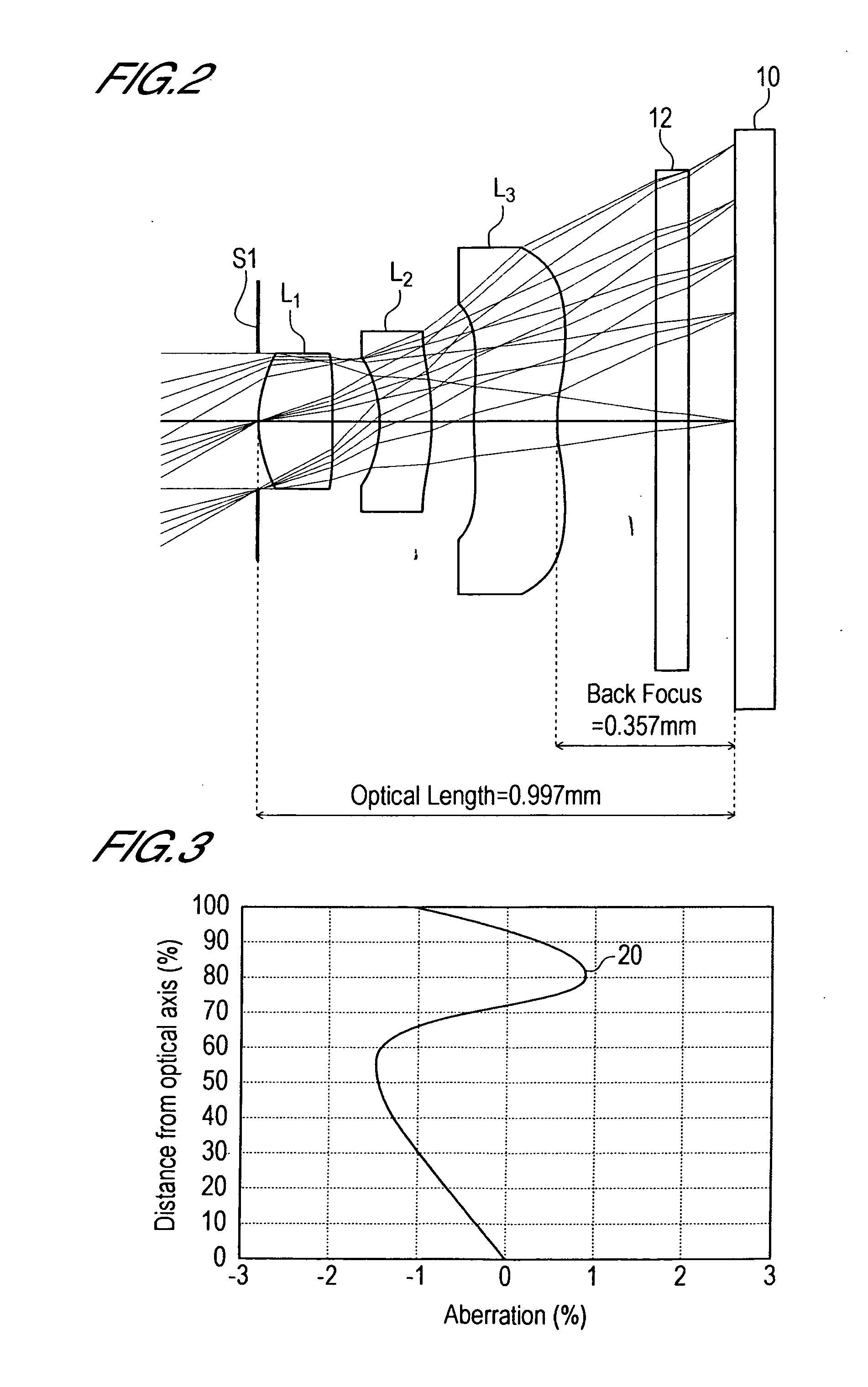Pickup lens
- Summary
- Abstract
- Description
- Claims
- Application Information
AI Technical Summary
Benefits of technology
Problems solved by technology
Method used
Image
Examples
first embodiment
[0150]Zeonex E48R was used as the material of the first lens L1 and third lens L3, while polycarbonate was used as the material of the second lens L2.
[0151](A) The focal length f1 of the first lens L1 is f1=0.58 mm.
[0152](B) The object-side radius of curvature r2 of the first lens L1 is r2=0.297 mm.
[0153](C) The image-side radius of curvature r3 of the first lens L1 is r3=5.941 mm.
[0154](D) The interval D along the optical axis between the second lens L2 and the third lens L3 is d3=0.1020 mm.
[0155](E) The optical length L is L=0.997 mm.
[0156](F) The image height (length of the diagonal line in the rectangular light-receiving area) 2Y is 2Y=1.18 mm.
[0157]Hence:
f1 / f=0.58 / 1.00=0.58 (1)
r2 / r3=0.297 / 5.941=0.0500 (2)
d3 / f=0.1020 / 1.00=0.1020 (3)
L / 2Y=0.997 / 1.18=0.8449 (4)
[0158]Hence the lens system of the first Embodiment satisfies each of the following condition equations (1) to (4).
0.57<f1 / f<0.65 (1)
0.01≦r2 / r3≦0.05 (2)
0.1≦d3 / f<0.15 (3)
0.6<L / 2Y<0.9 (4)
[0159]In the foll...
second embodiment
[0167]Zeonex E48R was used as the material of the first lens L1 and third lens L3, while polycarbonate was used as the material of the second lens L2.
[0168](A) The focal length f1 of the first lens L1 is f1=0.61 mm.
[0169](B) The object-side radius of curvature r2 of the first lens L1 is r2=0.323 mm.
[0170](C) The image-side radius of curvature r3 of the first lens L1 is r3=32.244 mm.
[0171](D) The interval D along the optical axis between the second lens L2 and the third lens L3 is d3=0.1108 mm.
[0172](E) The optical length L is L=1.042 mm.
[0173](F) The image height (length of the diagonal line in the rectangular light-receiving area) 2Y is 2Y=1.18 mm.
[0174]Hence:
f1 / f=0.61 / 1.00=0.61 (1)
r2 / r3=0.323 / 32.244=0.0100 (2)
d3 / f=0.1108 / 1.00=0.1108 (3)
L / 2Y=1.042 / 1.18=0.8831 (4)
[0175]Hence the lens system of the first Embodiment satisfies each of the following condition equations (1) to (4).
0.57f1 / f<0.65 (1)
0.01≦r2 / r3≦0.05 (2)
0.1≦d3 / f<0.15 (3)
0.6<L / 2Y<0.9 (4)
[0176]As shown in T...
third embodiment
[0183]Zeonex E48R was used as the material of the first lens L1 and third lens L3, while polycarbonate was used as the material of the second lens L2.
[0184](A) The focal length f1 of the first lens L1 is f1=0.62 mm.
[0185](B) The object-side radius of curvature r2 of the first lens L1 is r2=0.326 mm.
[0186](C) The image-side radius of curvature r3 of the first lens L1 is r3=20.315 mm.
[0187](D) The interval D along the optical axis between the second lens L2 and the third lens L3 is d3=0.1118 mm.
[0188](E) The optical length L is L=1.071 mm.
[0189](F) The image height (length of the diagonal line in the rectangular light-receiving area) 2Y is 2Y=1.20 mm.
[0190]Hence:
f1 / f=0.62 / 1.00=0.62 (1)
r2 / r3=0.326 / 20.315=0.0160 (2)
d3 / f=0.1118 / 1.00=0.1118 (3)
L / 2Y=1.071 / 1.20=0.8925 (4)
[0191]Hence the lens system of the first Embodiment satisfies each of the following condition equations (1) to (4).
0.57<f1 / f<0.65 (1)
0.01≦r2 / r3≦0.05 (2)
0.1≦d3 / f<0.15 (3)
0.6<L / 2Y<0.9 (4)
[0192]As shown ...
PUM
| Property | Measurement | Unit |
|---|---|---|
| Length | aaaaa | aaaaa |
| Radius | aaaaa | aaaaa |
| Height | aaaaa | aaaaa |
Abstract
Description
Claims
Application Information
 Login to View More
Login to View More - R&D
- Intellectual Property
- Life Sciences
- Materials
- Tech Scout
- Unparalleled Data Quality
- Higher Quality Content
- 60% Fewer Hallucinations
Browse by: Latest US Patents, China's latest patents, Technical Efficacy Thesaurus, Application Domain, Technology Topic, Popular Technical Reports.
© 2025 PatSnap. All rights reserved.Legal|Privacy policy|Modern Slavery Act Transparency Statement|Sitemap|About US| Contact US: help@patsnap.com



